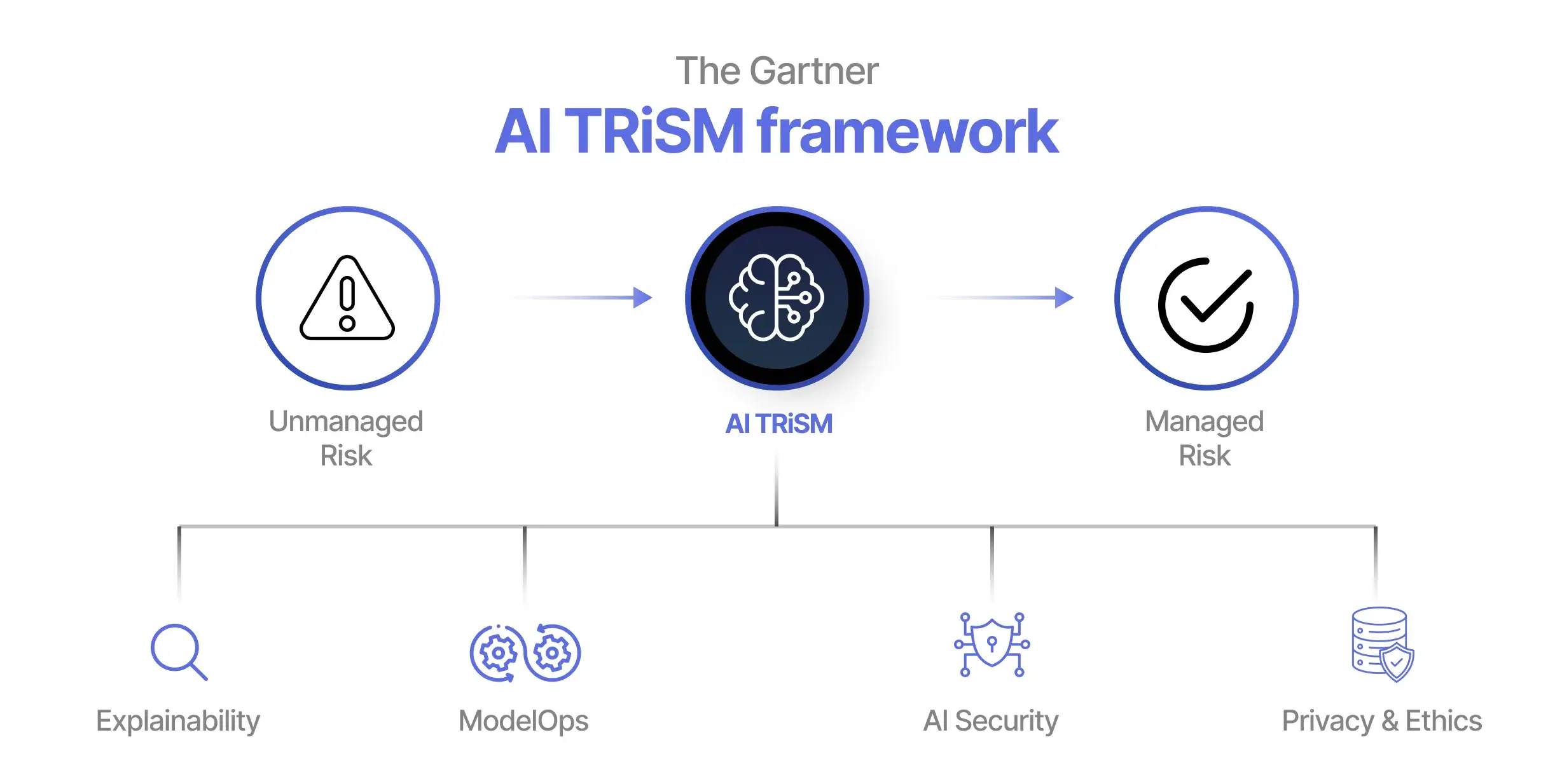The year 2024 marks a pivotal juncture in Information Technology (IT), with several key trends poised to redefine the industry’s landscape. These trends, each significant in its own right, collectively herald a new era of innovation and transformation. They are set to revolutionize various sectors, from business and healthcare to education and entertainment, reshaping our world profoundly. However, these trends also present new challenges and opportunities, necessitating a rethinking of traditional IT strategies and paradigms.
As we delve deeper into 2024, it becomes increasingly clear that understanding and adapting to these trends is beneficial and essential for anyone seeking to thrive in this rapidly evolving digital age. This blog post aims to delve deeper into the most significant IT trends shaping technology and business’s future.
AI Trust, Risk and Security Management (AI TRiSM): A New Frontier in Technology

Figure 1: AI Trust, Risk and Security Management (AI TRiSM): A New Frontier in Technology
In the rapidly evolving world of technology, one trend that has gained significant traction is AI Trust, Risk, and Security Management (AI TRiSM). This concept emphasizes the importance of trust, risk, and security in AI applications, creating guardrails to mitigate AI risks.
Trust is a fundamental aspect of any relationship, and it’s no different for humans and AI. As AI systems become more integrated into our daily lives, these systems must be trustworthy. Trust in AI is about ensuring that AI systems operate in a way that is ethical, transparent, and aligns with human values.
Risk management in AI involves identifying potential risks associated with AI applications and taking steps to mitigate them. These risks can range from biases in AI algorithms to privacy concerns. By proactively managing these risks, we can ensure that AI applications are used responsibly and ethically.
Security is another critical aspect of AI TRiSM. As AI systems become more sophisticated, so do the potential threats. Ensuring the security of AI systems involves protecting them from malicious attacks and ensuring the privacy and integrity of the data they process.
AI TRiSM is set to play a pivotal role in AI’s future. As AI continues to evolve and become more integrated into society, the importance of trust, risk management, and security will only increase. By prioritizing these aspects, we can ensure that AI is used in a way that benefits society as a whole while minimizing potential risks and threats.
AI TRiSM represents a significant step forward in AI’s responsible and ethical use. By focusing on trust, risk management, and security, we can ensure that AI systems are effective, trustworthy, secure, and beneficial to all.
Sustainable Technology: A Key to a Greener Future

Figure 2: Sustainable Technology: A Key to a Greener Future
In the era of rapid technological advancement, sustainable technology has emerged as a game-changer. This concept refers to the design and use of technology that contributes to environmental sustainability. It’s about leveraging technology to reduce our ecological footprint and promote a more sustainable future.
The rise of sustainable technology can be attributed to the growing awareness of environmental issues and the urgent need for sustainable solutions. As the effects of climate change become increasingly apparent, there is a pressing need for technologies to help mitigate these effects and promote sustainability.
In the IT sector, sustainable technology is becoming increasingly important. IT organizations are expected to have performance metrics tied to their sustainability. This means that IT organizations are evaluated not just based on their technical performance but also on their environmental impact.
Numerous examples of sustainable technology in action exist. For instance, data centers are designed to be more energy-efficient, reducing their carbon footprint. Similarly, many tech companies invest in renewable energy sources to power their operations.
Another example is using AI and machine learning to optimize energy usage. These technologies can analyze patterns in energy consumption and make recommendations for reducing energy waste.
The future of sustainable technology looks promising. As technology evolves, we can expect to see even more innovative solutions for promoting sustainability. For instance, the Internet of Things (IoT) could significantly promote energy efficiency and reduce waste.
Sustainable technology represents a significant step forward in our efforts to climate change and promote a more sustainable future. By leveraging technology, we can reduce our environmental impact and create a greener, more sustainable world.
Democratized Generative AI: Unleashing Creativity for All

Figure 3: Democratized Generative AI: Unleashing Creativity for All
In the realm of artificial intelligence (AI), one trend that is gaining significant momentum is Democratized Generative AI. This concept refers to the increasing accessibility of generative AI, which has the ability to create new content or models.
Generative AI is a subset of AI that focuses on creating new, previously unseen content. This can include creating new images, writing text, composing music, or even generating code. The power of generative AI lies in its ability to learn from existing data and generate new similar but not identical data.
The democratization of generative AI is about making this powerful technology accessible to everyone, regardless of their technical expertise. This means that you don’t need to be a data scientist or a machine learning expert to leverage the power of generative AI. With the right tools and platforms, anyone can use generative AI to create new content or solve complex problems.
The impact of democratized generative AI is far-reaching. For instance, in web and mobile app development, it’s expected that by 2026, generative AI will significantly alter 70% of the design and development effort. This means developers can leverage generative AI to automate parts of the development process, allowing them to focus on more complex and creative tasks.
In content creation, generative AI can create new and unique content, from articles and blog posts to music and artwork. This opens up new possibilities for creativity and innovation.
The future of democratized generative AI looks promising. As the technology continues to evolve and become more accessible, we can expect to see even more innovative applications of generative AI. Whether in software development, content creation, or problem-solving, democratized generative AI has the potential to transform the way we create and innovate.
Democratized generative AI represents a significant step forward in AI. By making this powerful technology accessible to all, we are opening up new possibilities for creativity and innovation. As we continue to explore the potential of generative AI, one thing is clear: the future of AI is not just about understanding the world but also about creating it.
As we navigate through 2024, these IT trends are shaping the future of technology and business. By understanding and embracing these trends, businesses can stay ahead of the curve and drive innovation and growth.
Remember, the future is not something that happens to us. It’s something we create. Let’s embrace these trends and build a better future together.







